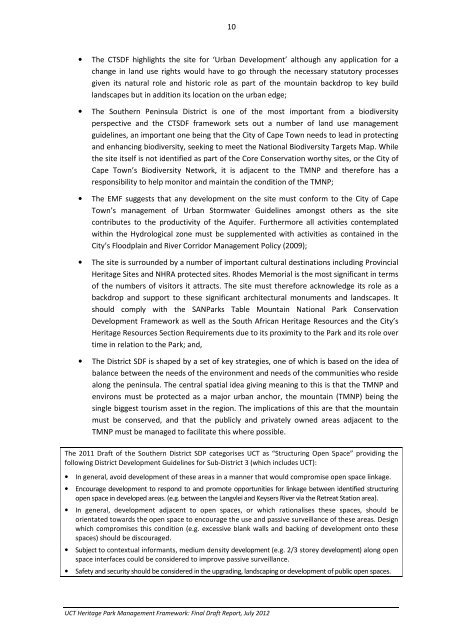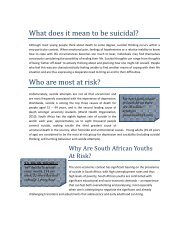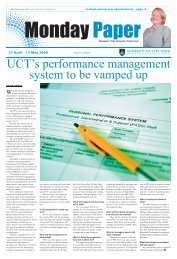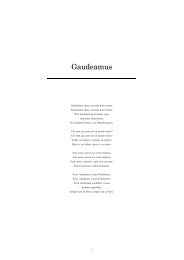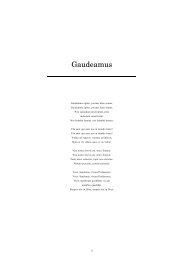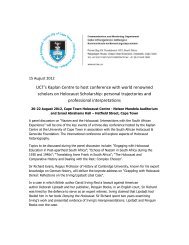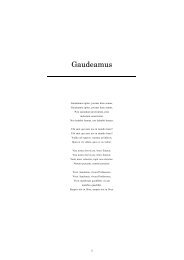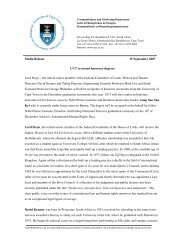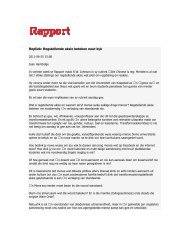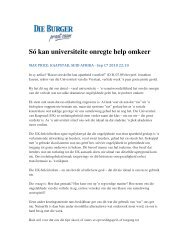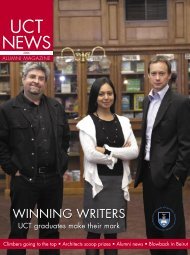uct heritage park management framework - University of Cape Town
uct heritage park management framework - University of Cape Town
uct heritage park management framework - University of Cape Town
You also want an ePaper? Increase the reach of your titles
YUMPU automatically turns print PDFs into web optimized ePapers that Google loves.
10<br />
• The CTSDF highlights the site for ‘Urban Development’ although any application for a<br />
change in land use rights would have to go through the necessary statutory processes<br />
given its natural role and historic role as part <strong>of</strong> the mountain backdrop to key build<br />
landscapes but in addition its location on the urban edge;<br />
• The Southern Peninsula District is one <strong>of</strong> the most important from a biodiversity<br />
perspective and the CTSDF <strong>framework</strong> sets out a number <strong>of</strong> land use <strong>management</strong><br />
guidelines, an important one being that the City <strong>of</strong> <strong>Cape</strong> <strong>Town</strong> needs to lead in protecting<br />
and enhancing biodiversity, seeking to meet the National Biodiversity Targets Map. While<br />
the site itself is not identified as part <strong>of</strong> the Core Conservation worthy sites, or the City <strong>of</strong><br />
<strong>Cape</strong> <strong>Town</strong>’s Biodiversity Network, it is adjacent to the TMNP and therefore has a<br />
responsibility to help monitor and maintain the condition <strong>of</strong> the TMNP;<br />
• The EMF suggests that any development on the site must conform to the City <strong>of</strong> <strong>Cape</strong><br />
<strong>Town</strong>’s <strong>management</strong> <strong>of</strong> Urban Stormwater Guidelines amongst others as the site<br />
contributes to the prod<strong>uct</strong>ivity <strong>of</strong> the Aquifer. Furthermore all activities contemplated<br />
within the Hydrological zone must be supplemented with activities as contained in the<br />
City’s Floodplain and River Corridor Management Policy (2009);<br />
• The site is surrounded by a number <strong>of</strong> important cultural destinations including Provincial<br />
Heritage Sites and NHRA protected sites. Rhodes Memorial is the most significant in terms<br />
<strong>of</strong> the numbers <strong>of</strong> visitors it attracts. The site must therefore acknowledge its role as a<br />
backdrop and support to these significant architectural monuments and landscapes. It<br />
should comply with the SANParks Table Mountain National Park Conservation<br />
Development Framework as well as the South African Heritage Resources and the City’s<br />
Heritage Resources Section Requirements due to its proximity to the Park and its role over<br />
time in relation to the Park; and,<br />
• The District SDF is shaped by a set <strong>of</strong> key strategies, one <strong>of</strong> which is based on the idea <strong>of</strong><br />
balance between the needs <strong>of</strong> the environment and needs <strong>of</strong> the communities who reside<br />
along the peninsula. The central spatial idea giving meaning to this is that the TMNP and<br />
environs must be protected as a major urban anchor, the mountain (TMNP) being the<br />
single biggest tourism asset in the region. The implications <strong>of</strong> this are that the mountain<br />
must be conserved, and that the publicly and privately owned areas adjacent to the<br />
TMNP must be managed to facilitate this where possible.<br />
The 2011 Draft <strong>of</strong> the Southern District SDP categorises UCT as “Str<strong>uct</strong>uring Open Space” providing the<br />
following District Development Guidelines for Sub-District 3 (which includes UCT):<br />
• In general, avoid development <strong>of</strong> these areas in a manner that would compromise open space linkage.<br />
• Encourage development to respond to and promote opportunities for linkage between identified str<strong>uct</strong>uring<br />
open space in developed areas. (e.g. between the Langvlei and Keysers River via the Retreat Station area).<br />
• In general, development adjacent to open spaces, or which rationalises these spaces, should be<br />
orientated towards the open space to encourage the use and passive surveillance <strong>of</strong> these areas. Design<br />
which compromises this condition (e.g. excessive blank walls and backing <strong>of</strong> development onto these<br />
spaces) should be discouraged.<br />
• Subject to contextual informants, medium density development (e.g. 2/3 storey development) along open<br />
space interfaces could be considered to improve passive surveillance.<br />
• Safety and security should be considered in the upgrading, landscaping or development <strong>of</strong> public open spaces.<br />
UCT Heritage Park Management Framework: Final Draft Report, July 2012


